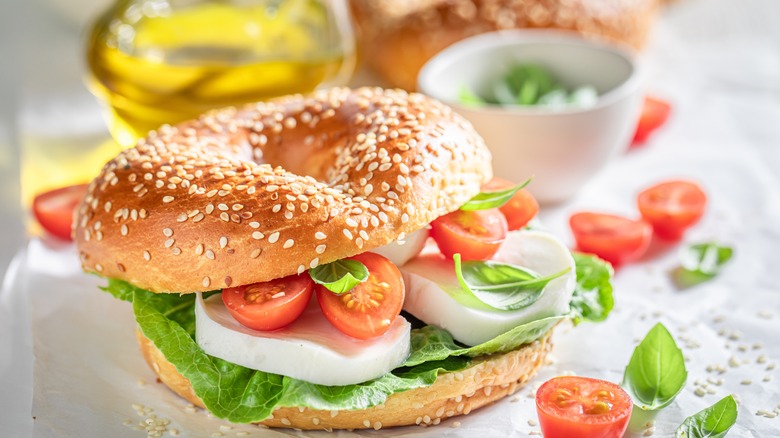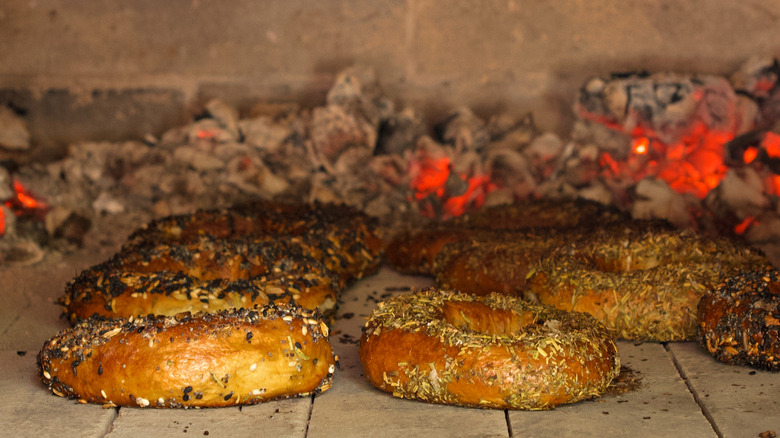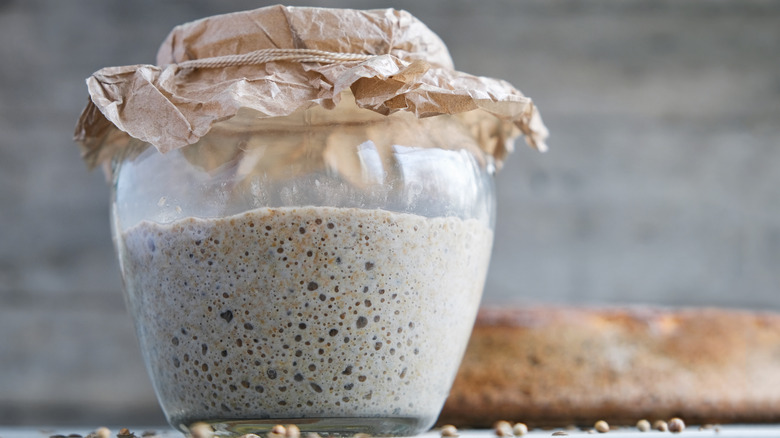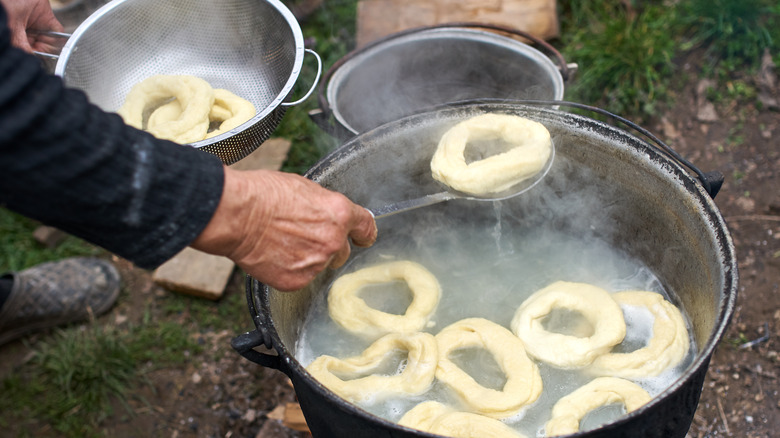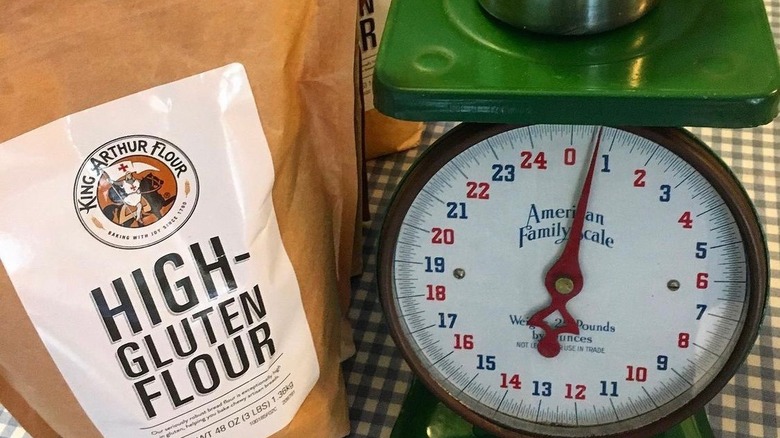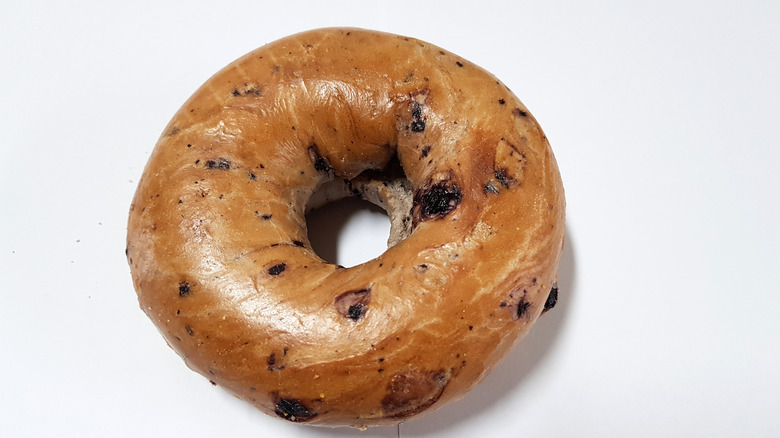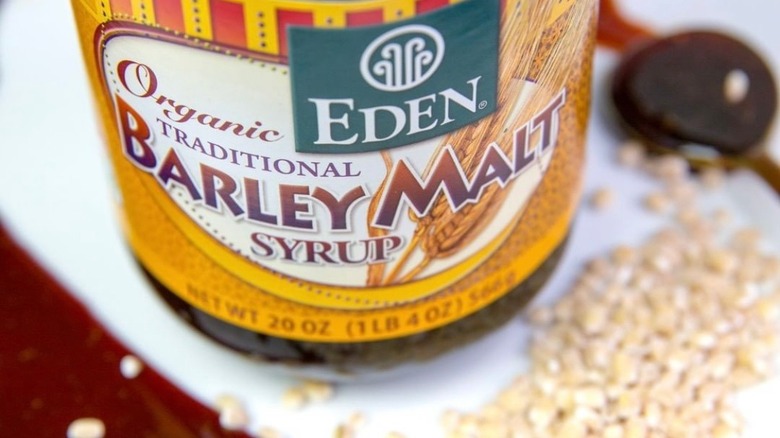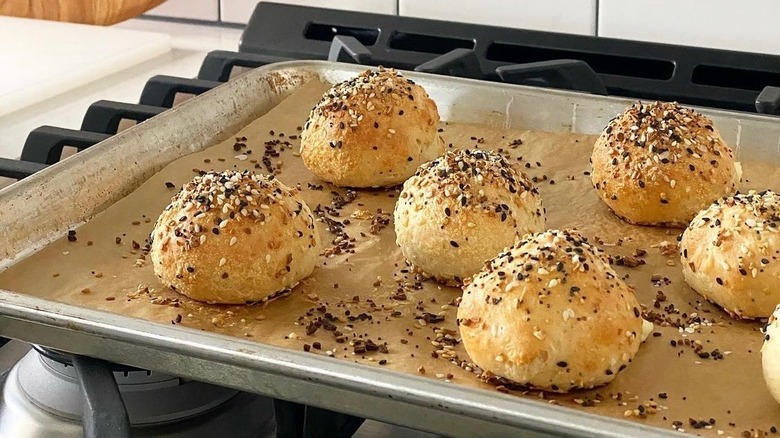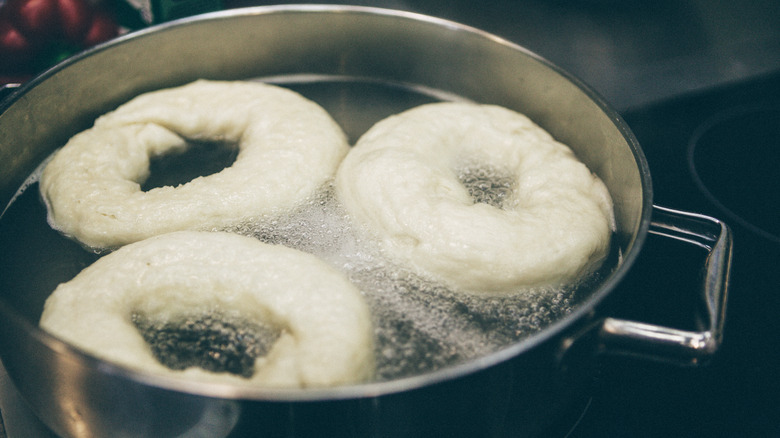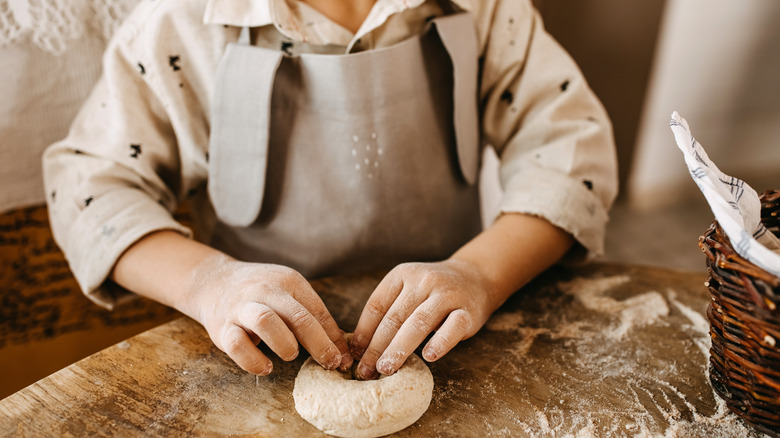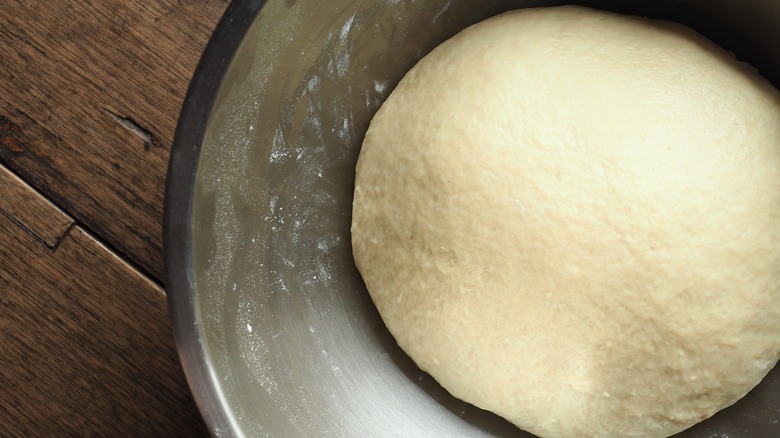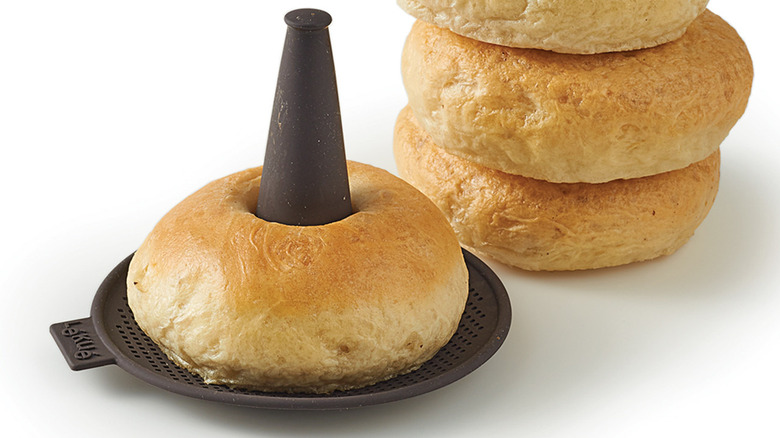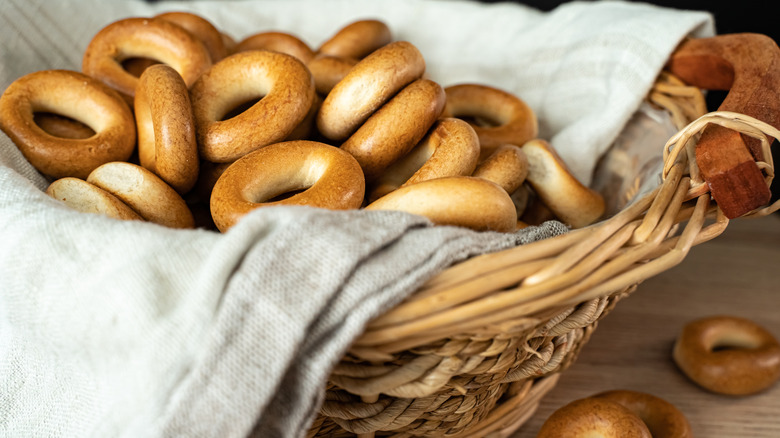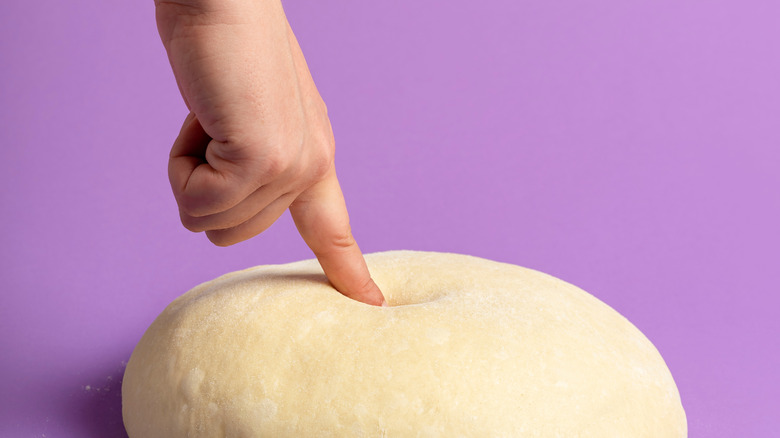14 Ways To Make Better Homemade Bagels
Bagels are a carby, chewy, nostalgic treat. This bread is typically formed in a round, donut shape with a hole in the middle. Unlike other types of bread, bagels are poached in water before baking; this gelatinizes the starch on the exterior of the bagel and results in a crisp exterior and chewy interior. Bagels can be served in a variety of ways including open-faced with a schmear of cream cheese, hummus, or peanut butter, or as the base for a breakfast sandwich.
If you are continuously disappointed with the lackluster flavor and texture of a store-bought bagel, you might think to try baking homemade bagels in your kitchen. Although it's a great idea, in theory, baking bagels is actually a laborious process that takes hours of rising, forming, poaching, and baking. We've consulted Tyler Bean, owner of Willow's Bagels in Burlington, Vermont for some of his tips for bagel novices on perfecting the ideal bagel at home.
Try baking bagels in a wood-fired oven
Montreal bagels are a distinctive bagel style that is both formed and baked differently than other conventional bagels. According to TreeHugger, Montreal bagels are formed by swinging a rope of dough into a log and coined into a circle. From there, a bagel maker will poach the dough in brown sugar water for a sweet crust before being baked in a wood-fired oven. The result is a bagel with a large hole in the center and an uber-crispy crust.
Many large Montreal bagel companies have ovens specifically devoted to baking the bagels. It's unlikely that a home chef would have the same wood-fired oven in their kitchen. If you're really looking to enhance your bagel-making experience, though, you can purchase an outdoor wood-fired oven for around $400. These ovens can bake more than just bagels; pizza, spare ribs, pulled pork, and corn-on-the-cob are just some of the many foods you can bake in your outdoor oven.
Use a poolish starter for a distinct flavor
Sourdough starter is a collection of yeast and bacteria that produce carbon dioxide when they metabolize. This carbon dioxide is used as a leavening agent in baked bread, but it can also be a powerful leavener in dense bagel dough. Plus, using sourdough in a bagel recipe adds a distinct acidic flavor.
Tyler and the crew at Willow's use a poolish starter for a "unique and sweet funk." According to The Pantry Mama, the poolish starter contains equal parts water and flour, as well as commercial yeast as opposed to a starter made with wild yeasts and bacteria. Tyler notes that he first started out with a wild sourdough but found the flavor to be a little too acidic and the upkeep to be too intensive. The poolish starter method has to sit for between 12 and 24 hours (Willows allows its poolish to sit for between 12 and 16 hours) before being added to the dough. If you're making bread for the first time, Tyler recommends the poolish for a more reliable result.
Be extra gentle with the uncooked bagels
Bagels are very impressionable and easily damaged by collisions in the poaching pot or when the dough puffs are rising. As a homemade bagel baker, you'll want to provide ample room for the poached bagels to increase in size and float around. Senior recipe tester Molly Marzalek-Kelly at King Arthur Baking Company attests to the gentility required to handle and shape the perfect bagel. She notes that over-proofed bagels are more delicate than slightly under-proofed bagels, so cutting a few minutes off a second proof may be the difference between a sad, deflated bagel and a nice, puffy one. Tyler notes that bagels with ideal proofing are much sturdier than over-proofed bagels that deflate when pressed.
When Molly submerges her bagels in the water, she uses both of her hands to place the bagels gently in the water. To remove the bagels, she recommends using a slotted spoon or a dough whisk. Although these kitchen tools may seem minor, they are important in protecting the shape of the bagel once it is moved from the poaching to the baking step. "All you can really do is be slow and intentional if you run into over proofing," Tyler adds.
Use a high-gluten flour
Gluten is a vital protein in making a strong bagel. The Washington Post recommends bakers use high-protein gluten flour (or "bread flour") with around 13% gluten as opposed to an all-purpose baking flour with around 11% gluten. You'll notice a tangible difference in the elasticity of bread flour versus all-purpose flour. According to Tyler, bagels with high gluten have a better crumb structure while all-purpose have an interior more reminiscent of white bread.
The exact ratio of bread flour to all-purpose flour in the perfect bagel depends on the recipe. King Arthur Baking Company only uses high-gluten flour for its bagels, while other recipes only use all-purpose flour for the bagel recipe. If you plan on making a 3-ingredient everything bagel recipe with Greek yogurt, you'll want to use self-rising flour to account for the absence of yeast in the recipe otherwise. Which way is the right way? Well, Peter Reinhart, author and professional baker, notes that a high gluten flour is absolutely essential in establishing a chewy, strong gluten structure (via Peter Reinhart's Artisan Breads Every Day).
Add toppings in the dough
If you go to a bagel shop and peruse the bakery case, you'll notice the boring sesame, everything, and salt bagels. There's actually an entire world of exciting bagel flavors that are hidden within the deep, doughy folds of the bagel. The Institute of Culinary Education notes that you should add any flavorings to the bagel during the final proof. Consider making a cinnamon sugar bagel by adding cinnamon and brown sugar to the dough; you can also finish this cinnamon bagel with a sprinkle of granulated sugar. For a savory option, consider toasting and stirring in fennel seeds to the dough as it bakes. The fennel roasted fennel seeds give off a warm, toasty aroma and pair well with garlicky cream cheese or hummus spread.
If you plan on adding a scant amount of frozen fruit to your bagels, King Arthur Baking Company recommends rinsing and drying the fruit before stirring it into the bagel dough. Although this trick is usually used for muffins, rinsing and drying fruit will minimize bleeding into the surrounding bagel dough and keep your bagels a light brown color. If you plan on using sun-dried tomatoes, the Institute of Culinary Education suggests drying off excess oil to avoid messing with the texture of the dough.
Work quickly to add toppings to your bagels
If you've bought bagels in a bag before, you'll understand the familiar feeling of opening the bag and realizing your bagels aren't actually everything bagels anymore. Instead, the seasonings are at the bottom of the bag and you merely have a plain bagel.
There are some tricks to keeping that sprinkle of toppings on your bagel during the baking and storage process. Tyler recommends setting up an effective mise en place with a bowl large enough to fit the bagel. Once the bagels are finished poaching, let the water drip from the bagel before dipping the bagel into the bowl. Tyler estimates a 20- to 30-second window before the bagel is too dry to add the toppings.
The authors of Modernist Bread, as reported by Modernist Pantry, recommends coating poached bagels in a tapioca starch slurry before baking. After the slurry is applied to the bagels, seeds and seasonings can be sprinkled on top. Then, the bagels are baked until golden brown. Tyler was a proponent of this method in the beginning but found it takes much more time than the dry-and-sprinkle method. Other bagel bakers swear by an egg wash to help the toppings stick to the crusty exterior. For a simple egg wash, beat an egg white and apply a sheer coat to the bagel before sprinkling the toppings.
Add barley malt syrup to the poaching liquid
You may associate "malt syrup" with a milkshake, but this humble ingredient actually plays a big role in the sweetness, flavor, and color of the perfect bagel. King Arthur Baking Company notes that malt is a byproduct of the barley grain (sorry gluten-free folks) that imparts an amber color when incorporated into bread. Tyler uses barley malt syrup for its flavor in the dough, as well as during poaching.
If you can't find barley malt syrup at the grocery store, you substitute diastatic malt powder at a ratio of 0.8 grams of powder for every 1 gram of syrup, per King Arthur Baking Company. Using diastatic malt powder may cause the dough to rise faster, so be wary of adjusted rise times when using the ingredient. You can also substitute brown sugar or non-diastatic malt powder in the dough and honey in the poaching liquid to impart a sweet flavor. King Arthur Baking Company notes that because the quantity of syrup is so minimal in the recipe, it will not significantly alter the hydration of the dough if substituted for a dry ingredient like brown sugar.
Try making stuffed bagel bites
Bagel bites are a quick, grab-and-go breakfast option common at Dunkin' and Starbucks. You can fill the bagels with any of your favorite cream cheeses including strawberry, low-fat, or scallion chive. King Arthur Baking Company recommends adding extra shredded cheese to the bagel dough to help increase the cheesy flavor — and to keep the dough moist. The company also recommends freezing the balls of cream cheese for easy handling when it comes time to bake. Freezing the cream cheese also allows the baker to move the dough around the cream cheese and ensure that all of the edges are sealed shut for the poaching process, per Handle the Heat. After the bagels are poached, each ball is transferred to a baking sheet where it is baked until golden brown. In short, if you can make a good bagel, you can make a good bagel bite.
Bagel bites are an easy breakfast to make ahead and defrost in the microwave when you're ready to eat. Finish the bagel bites with your favorite toppings; we recommend everything bagel seasoning or sesame seeds.
Alter poaching time based on desired bagel qualities
Depending on what bagel recipe you look at, you're bound to find a lot of disparities in the poaching time for the perfect bagel. According to Food Crumbles, poaching time is decided on three important factors. The first is the thickness of the bagel because thicker bagels can withstand a longer poaching time. The next is the texture of the bagel. A longer poaching time gelatinizes more starch on the bagel, rendering it chewier. Although a little bit of chew is desirable, boiling a bagel for several minutes may render the dough too tough to bite into. The poaching time also impacts the last yeast "puff" in the oven, so bagels that have a longer poaching time do not typically change shape or size in the oven post-bake.
Most bagels should not boil for over 60 seconds, according to Knead Rise Bake. This time is short enough to gelatinize the starch, but not long enough to cook the interior of the bagel. Once the bagel is in the oven, you'll notice a fair amount of yeast rise and a soft interior. Voilà!
Shape the bagel correctly
Kye Ameden, an editorial contributor at King Arthur Baking Company, describes the two primary ways bagels are shaped. You can first shape the bagels into tiny balls by stretching the dough and pinching the seam at the top (similar to a dumpling). This method creates a round shape that can then be punctured in the center by a floured finger. Once the dough is punctured, the hole needs to be opened so it is no more than 2 inches in diameter. To form the shape of the bagel, Kye recommends twirling the bagel around and stretching the hole slowly. It is important to make sure the hole is the correct size to preserve the thickness (and fluffy interior) of the bagel.
The second method is more common with Montreal bagels and similar to the pretzel-making method. The bagel dough is rolled out into a log between 8 and 10 inches in length. Then, wet the end of the log in the water and roll the dough around your hand, overlapping the ends. Seal the ends by rolling your palm into the log. Moreover, sealing the strand together prevents the dough from breaking apart during the poaching process.
Consider the impact of altitude on the bagel
Altitude determines air pressure, so, logically, a baker must consider how their location impacts their baked goods. King Arthur Baking Company notes that liquid, flour, and leaveners are all susceptible to changes in altitude. The low pressure experienced at higher altitudes causes baked goods to leaven more quickly and bake more quickly. Baking experts recommend decreasing oven temperature to about 20 F at high altitudes (3,500 feet) to reduce the risk of burning baked goods.
Yeast should also be decreased by about 25% to account for changes in microbial activity. Bakers can take some steps to slow the microbial activity in their bagels by giving the dough a punch and extra rise before forming the bagels, placing the dough in the refrigerator for the first rise, and substituting some of the liquid in the recipe for a slow-moving sourdough starter. Bakers should also prepare for big rises by using a large bowl for mixing and rising, according to Baking Bites.
Consider purchasing a scale and molds
Uniform bagels are desirable, not only because nobody wants the smallest bagel in the batch, but because bagels that are the same size cook evenly. If you struggle to keep your bagels the same size, you'll first want to invest in a kitchen scale. Our bagel recipe recommends keeping the dough at around 100 grams. If you make a heavier dough, you'll want to divide the total weight by the number of bagels you plan to make.
Uniform bagels aren't just similar in size; the bagels are also similar in shape. You can purchase bagel molds from King Arthur Baking Company. These silicon molds are conical in shape and allow you to form your bagels by pressing the tip through the dough. You can boil your bagels on the molds and allow the bagels to float off, or just transfer the whole mold to the baking sheet.
Do not store bagels in the fridge
It's a bad idea to refrigerate bread (including bagels) because the conditions of the refrigerator promote staleness. The starches in the bread will quickly crystalize and destroy the texture of everything from English muffins to ciabatta. Instead of refrigerating your bread, we recommend leaving it on your countertop and eating it before the best-by date. If you decide to bake a big batch of bagels and don't have anyone to share the batch with, you should think about freezing your bagels. The freezer is at a cool enough temperature that the bread doesn't have enough time to crystalize before it freezes. Plus, placing the bagels in the freezer makes it easy to pop one out of the bag when you need an easy breakfast.
According to Medina Baking, there is no exact time for how long bagels last in the fridge because different recipes use different ingredients. As a general rule of thumb, fresh bagels stay fresh in an air-tight bag for up to five days.
Cold proof your bagels overnight
Cold proofing is the process of preparing bread the night before and allowing the dough to refrigerate overnight before baking. Although Tyler notes that cold-proofing bagels are time-consuming (since the bagels prove much quicker at room temperature), the process is vital for flavor development. According to Cooks' Illustrated, the yeast produces carbon dioxide at a slower speed in the refrigerator; the time also allows the dough to develop more complex flavor molecules.
Tyler knows the bagels are ready for the cold fermentation step once the dough is relaxed and has already gone through its first proof. The dough should be tender and stretch a little bit from its own weight when pulled with two hands. It will be easy to determine this because the cold fermentation process happens after the bagels are shaped. Once it is placed in the fridge, the yeast should be allowed to ferment undisturbed until it's ready to be poached and baked the next morning.
